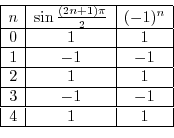Next: Extreme Value of Functions Up: Differentiation Previous: Limit of Indeterminate Form Contents Index
Is it possible to express transcendental function  such as
such as  ,
,  ,
,  ,
,
 using polynomials? The next theorem answers such a question.
using polynomials? The next theorem answers such a question.
Taylor's Theorem
 is class
is class  on
on ![$[a,b]$](img1084.png) . Then there exists
. Then there exists  in
in  such that
such that


NOTE Note that for  , we have
, we have
 , where
, where
 . Thus for
. Thus for  , Taylor's theorem is the same as Mean Value Theorem. For
, Taylor's theorem is the same as Mean Value Theorem. For  , we have
, we have
 , where
, where  is the difference of the value of line
is the difference of the value of line
 and function
and function  at
at  . In other words,
. In other words,  is an error caused by approximation of the value of
is an error caused by approximation of the value of  by the line. Similarly,
by the line. Similarly,  is an approximation error of
is an approximation error of  by a quadratic polynomial.
by a quadratic polynomial.
Proof
Let  be an expression satisfying
be an expression satisfying


 . Thus
. Thus  satisfies the condition of Rolle's Theorem . Thus
satisfies the condition of Rolle's Theorem . Thus
 |
 |
 |
|
 |
 |
||
 |
 |

In Taylor's theorem with  is called Maclaurin's Theorem. Set
is called Maclaurin's Theorem. Set  . Then we have
. Then we have


 , where
, where
![$\displaystyle \vert R_{n}\vert = \vert\frac{f^{(n)}(\theta x)}{n!}x^{n}\vert \l...
...ax_{\theta \in [0,1]}\vert f^{(n)}(\theta x)\vert)\frac{\vert x\vert^{n}}{n!}. $](img2016.png)
 .
.

SOLUTION
Since
 , we have
, we have
 . Find a Taylor polynomial around
. Find a Taylor polynomial around  , we have
, we have





 , we have
, we have
 . Thus Taylor polynomial around
. Thus Taylor polynomial around  is
is
 Now we divide this into two cases.
Now we divide this into two cases.
 is even. Let
is even. Let  . Then
. Then

 is odd. Let
is odd. Let  . Then
. Then
 .
Thus
.
Thus
 |
 |
 |


| MacLaurin Series Expansion of Basic Functions | ||||||||||||
|---|---|---|---|---|---|---|---|---|---|---|---|---|
|
Theorem 2..15
|
NOTE
To show MacLaurin series expansion, we need to show
 . But it is not easy to show
. But it is not easy to show
 by using Lagrange's Remainder
by using Lagrange's Remainder  . So, we use different method. Suppose we express a MacLaurin series expansion of
. So, we use different method. Suppose we express a MacLaurin series expansion of  as
as
 . Then showing
. Then showing  approachs 0 is the same as showing
approachs 0 is the same as showing
 converges. To show
converges. To show
 converges, it is useful Limit Ration Test.
converges, it is useful Limit Ration Test.
| Limit Ration Test |
|---|
|
Theorem 2..16 Suppose
 be a nonnegative series. If be a nonnegative series. If
 , then , then
 converges. converges. |
 2.
2.

 . Then since
. Then since
 , we have
, we have
 . Thus Taylor polynomial
. Thus Taylor polynomial  for
for  is
is

 . Then apply the limit ration test.
. Then apply the limit ration test.

 ,
,
 converges. Therefore
converges. Therefore
 and,
and,

2. Let
 . Then since
. Then since
 , we have
, we have
 . Now for
. Now for  is even,
is even,
 and for
and for  , we have
, we have
 . Thus
. Thus

 . Then by the limit ration test,
. Then by the limit ration test,
 |
 |
 |
|
 |
 |
 ,
,
 converges. Therefore,
converges. Therefore,
 and
and

 2.
2.

 . Then since
. Then since
 , we have
, we have
 . Thus Taylor polynomial
. Thus Taylor polynomial  is
is
 Let
Let
 . Then by Limit Ratio Test, we have
. Then by Limit Ratio Test, we have

 ,
,
 converges. Therefore,
converges. Therefore,
 and
and

 . Then
. Then
 . Put
. Put  . Then
. Then


 .
Let
.
Let
 and apply Limit Ratio Test. Then
and apply Limit Ratio Test. Then

 ,
,
 converges. Therefore,
converges. Therefore,
 and
and

Proof
Landau little o
 has Maclaurin series expansion. Then
has Maclaurin series expansion. Then




SOLUTION
Since the denominator is  , we find Taylor polynomial of 2nd degree of
, we find Taylor polynomial of 2nd degree of
 .
.


 |
 |
 |

SOLUTION Since the denominator is  , we find Taylor polynomial of 3rd degree of
, we find Taylor polynomial of 3rd degree of
 .
.
 implies ,
implies ,
 |
 |
 |
|
 |
 |
 |
 |
 |
|
Exercise A
|
|
Exercise B
|
(c)

???????C

(d)
 ,
,

(a) By the exercise 1(d)?Cwe can obtain
 Now using this fact, calculate
Now using this fact, calculate  ?D
?D
(b)
 is called Machin's formula?DUsing this formula, calculate
is called Machin's formula?DUsing this formula, calculate  100 digts after the decimal point?D
100 digts after the decimal point?D